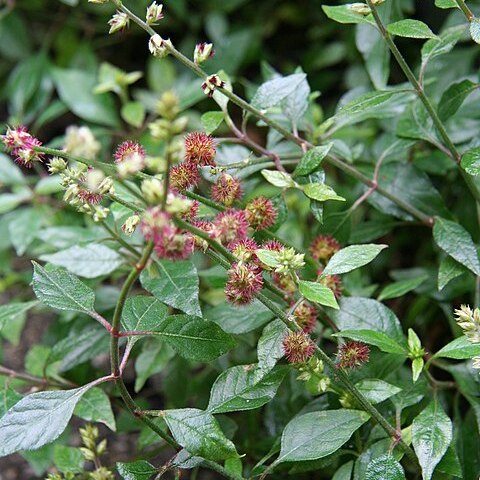Herbs, sometimes woody at the base. Leaves opposite, entire. Flowers spicate or racemed; spikes (racemes) terminal and axillary; lower part of spike (raceme) in axils of persistent bracts with a flower-cluster consisting of 2-3 bibracteolate ☿ flowers accompanied by some rudimentary ones; highest flowers often solitary and ☿, without rudimentary flowers. Tepals 5, free, with scarious margins, 3-5-nerved, not indurate at base. Stamens 5, at the base connate in a very short cup; no pseudo-staminodes; anthers oblong, 2-celled (4-locellate). Ovule 1, pendulous from a long funicle; style filiform; stigma capitate. Utricle oblong-obovoid, subcompressed; pericarp thin with a sharply delimitated somewhat thicker apex, which finally falls off letting out the seed; rudimentary flowers consisting of fascicled squarrose hooks; clusters falling off (with the bracteoles) as a whole, by means of the hooks, readily and firmly adhering to passers-by.
Inflorescence a spiciform bracteate thyrse terminal on the stem and branches, each bract subtending a single hermaphrodite flower on each side of which is set a bracteolate modified flower consisting of a number of sharply hooked spines, or, more commonly, each bract containing a hermaphrodite flower sub tended by two or more such triads each contained with a large bracteole.
Spines of modified flowers at first very small, rapidly accrescent, finally disposed in 3 or occasionally more stalked clusters of 5–20 spines in 1–3 ranks, the clusters stellately or occasionally dendroidly set on a common stalk, subequalling to much exceeding the perianth and serving as a means of distributing the fruit.
Stamens 5, the filaments delicate to rather solid, fused at the extreme base on to a fleshy, lobed, disk-like cup into which the base of the ovary is narrowed; pseudostaminodes absent; anthers bilocular.
Bracts persistent, finally more or less deflexed, entire partial inflorescences falling intact in fruit.
Fruit a thin-walled capsule irregularly ruptured below the firm apex by the developing seed.
Annual or perennial herbs or subshrubs with entire, opposite leaves.
Seed oblong-ovoid or ovoid, slightly compressed.
Ovary with a single, pendulous ovule.
Style slender, stigma capitate.
Perianth segments 5.
Endosperm copious.

